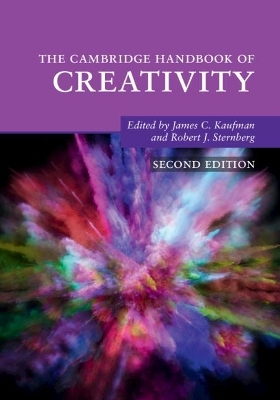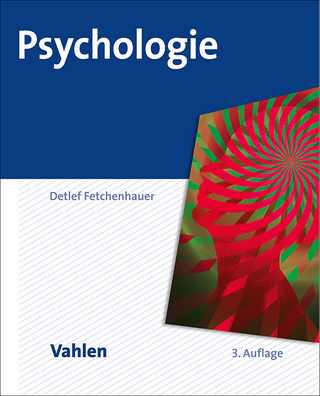
The Cambridge Handbook of Creativity
Cambridge University Press (Verlag)
978-1-316-63854-5 (ISBN)
This second edition of the renowned Cambridge Handbook of Creativity expands on the first edition with over two thirds new material reaching across psychology, business, entrepreneurship, education, and neuroscience. It introduces creativity scholarship by summarising its history, major theories and assessments, how creativity develops across the lifespan, and suggestions for improving creativity. It also illustrates cutting-edge work on genetics and the neuroscience of creativity, alongside creativity's potential for both benevolence and malevolence. The chapters cover the related areas of imagination, genius, play, and aesthetics and tackle questions about how cultural differences, one's physical environment, mood, and self-belief can impact creativity. The book then examines the impacts on creativity of behaviour by teachers, managers, and leaders in particular.
James C. Kaufman is Professor of Educational Psychology at the University of Connecticut. He has won the Mensa Award for Excellence in Research, the Torrance Award, and the American Psychological Association's (APA) Berlyne, Arnheim, and Farnsworth awards. Robert J. Sternberg is Professor of Human Development at Cornell University. He has won the Association for Psychological Science (APS) James McKeen Cattell and William James Awards as well as the Grawemeyer Award in Psychology.
An introduction to the second edition: divergences and some convergences James C. Kaufman and Robert J. Sternberg; Part I. An Introduction to Creativity; Section 1. The Nature of Creativity: 1. Creativity: a historical perspective Vlad P. Glăveanu and James C. Kaufman; 2. A review of creativity theories: what questions are we trying to answer? James C. Kaufman and Vlad P. Glăveanu; 3. Assessment of creativity Jonathan A. Plucker, Matthew C. Makel and Meihua Qian; 4. Understanding the development of creativity across the lifespan Anna N. N. Hui, Mavis W. J. He and Wan Chi Wong; 5. Enhancing people's creativity Robert J. Sternberg; Part II. Underpinnings of Creativity; Section 1. Biological Underpinnings: 6. Evolutionary approaches to creativity Aaron Kozbelt; 7. The genetic basis of creativity: a multivariate approach Baptiste Barbot and Henry Eff; 8. Neuroscience of creativity Oshin Vartanian; Section 2. Cognitive Underpinnings of Creativity: 9. Creative cognition Thomas B. Ward and Yuliya Kolomyts; 10. Creativity and cognitive control Mathias Benedek and Emanuel Jauk; 11. Divergent thinking Mark A. Runco and Selcuk Acar; Section 3. Affective Underpinnings of Creativity: 12. In the mood for creativity Matthijs Baas; 13. Emotions and creativity: from process to person and product Zorana Ivcevic and Jessica Hoffmann; 14. Creativity and mental illness Shelley H. Carson; 15. Creativity and healing Marie Forgeard; Part III. Differential Bases for Creativity; Section 1. Individual Differences in Creativity: 16. The relation of creativity to intelligence and wisdom Robert J. Sternberg, James C. Kaufman and Anne M. Roberts; 17. The function of personality in creativity: updates on the creative personality Gregory J. Feist; 18. Motivation and creativity Beth A. Hennessey; 19. Creative self-beliefs Maciej Karwowski, Izabela Lebuda and Ronald A. Beghetto; Section 2. Environmental Differences in Creativity: 20. Cultural perspectives on creativity Todd Lubart, Vlad P. Glăveanu, Henrie de Vries, Ana Camargo and Martin Storme; 21. Eastern-Western views of creativity Weihua Niu; 22. Creativity's role in society Dean Keith Simonton; 23. The physical environment and creativity: a theoretical framework Jan Dul; Part IV. Creativity in the World; Section 1. Collaborative Creativity: 24. Improving creativity in organizational settings: applying research on creativity to organizations Roni Reiter-Palmon, Kevin S. Mitchell and Ryan Royston; 25. Leading for creativity: a tripartite model Michael D. Mumford, Robert Martin, Samantha Elliott and Tristan McIntosh; 26. Individual and group creativity R. Keith Sawyer; Section 2. Contexts for Creativity: 27. Creativity in classrooms Ronald A. Beghetto; 28. Play and creativity Sandra W. Russ and Ellen A. Doernberg; 29. The creative city Richard Florida; 30. Creativity's role in everyday life Katherine N. Cotter, Alexander P. Christensen and Paul J. Silvia; Section 3. Manifestations of Creativity: 31. Creative genius Dean Keith Simonton; 32. Creativity and malevolence: past, present and future David H. Cropley and Arthur J. Cropley; 33. Creativity and aesthetics Pablo P. L. Tinio; 34. Imagination is the seed of creativity Rebecca J. M. Gotlieb, Elizabeth Hyde, Mary Helen Immordino-Yang and Scott Kaufman; 35. What is and what can be: the scope and possibilities of creativity and creativity research James C. Kaufman, Vlad P. Glăveanu and Robert J. Sternberg
| Erscheinungsdatum | 25.04.2019 |
|---|---|
| Reihe/Serie | Cambridge Handbooks in Psychology |
| Zusatzinfo | Worked examples or Exercises; 13 Tables, black and white; 1 Halftones, black and white; 8 Line drawings, black and white |
| Verlagsort | Cambridge |
| Sprache | englisch |
| Maße | 178 x 253 mm |
| Gewicht | 1430 g |
| Themenwelt | Geisteswissenschaften ► Psychologie ► Allgemeine Psychologie |
| Geisteswissenschaften ► Psychologie ► Pädagogische Psychologie | |
| Geisteswissenschaften ► Psychologie ► Verhaltenstherapie | |
| Sozialwissenschaften ► Soziologie | |
| ISBN-10 | 1-316-63854-5 / 1316638545 |
| ISBN-13 | 978-1-316-63854-5 / 9781316638545 |
| Zustand | Neuware |
| Informationen gemäß Produktsicherheitsverordnung (GPSR) | |
| Haben Sie eine Frage zum Produkt? |
aus dem Bereich


